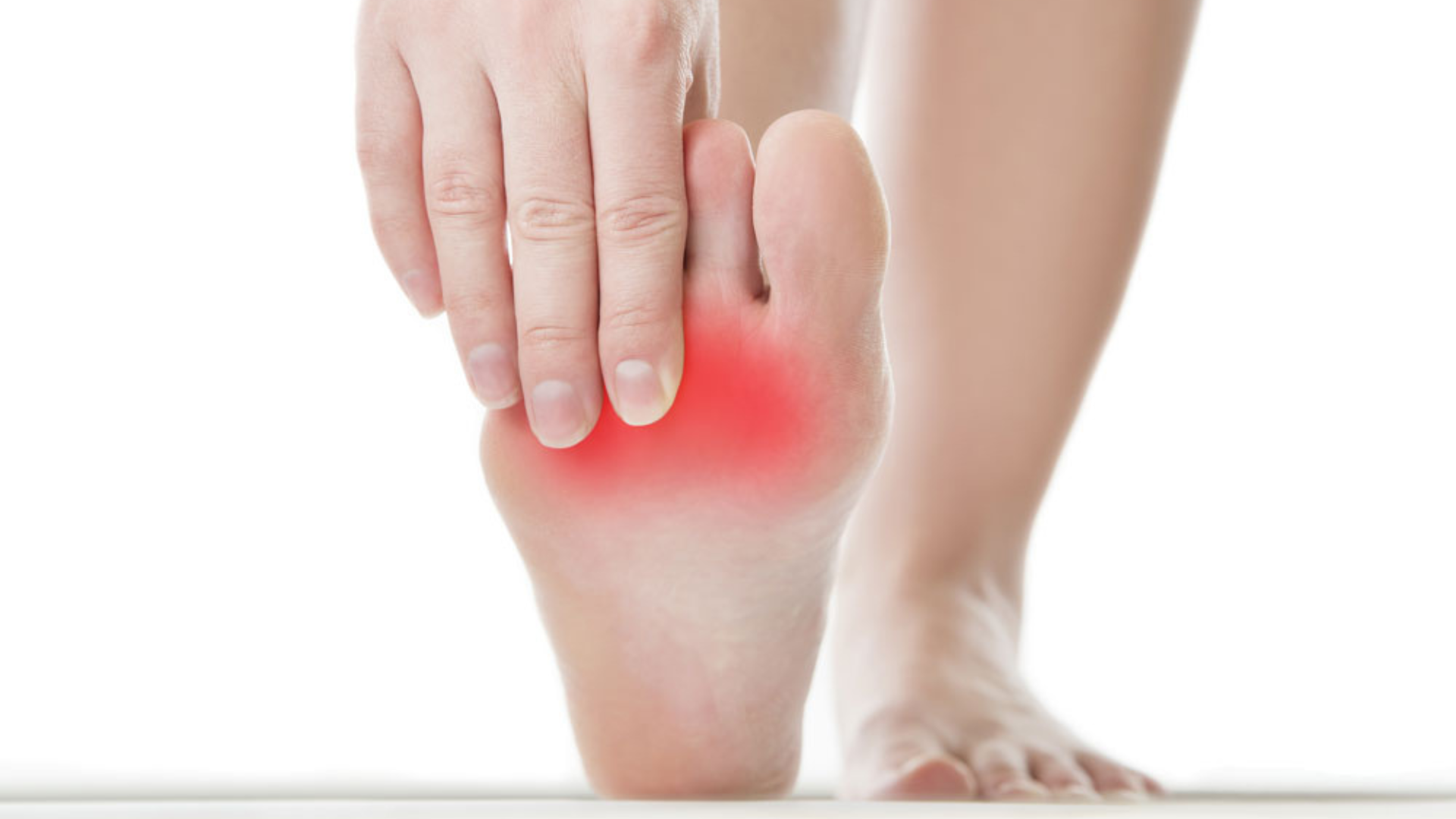Sports Podiatry Clinic Taylors Lakes
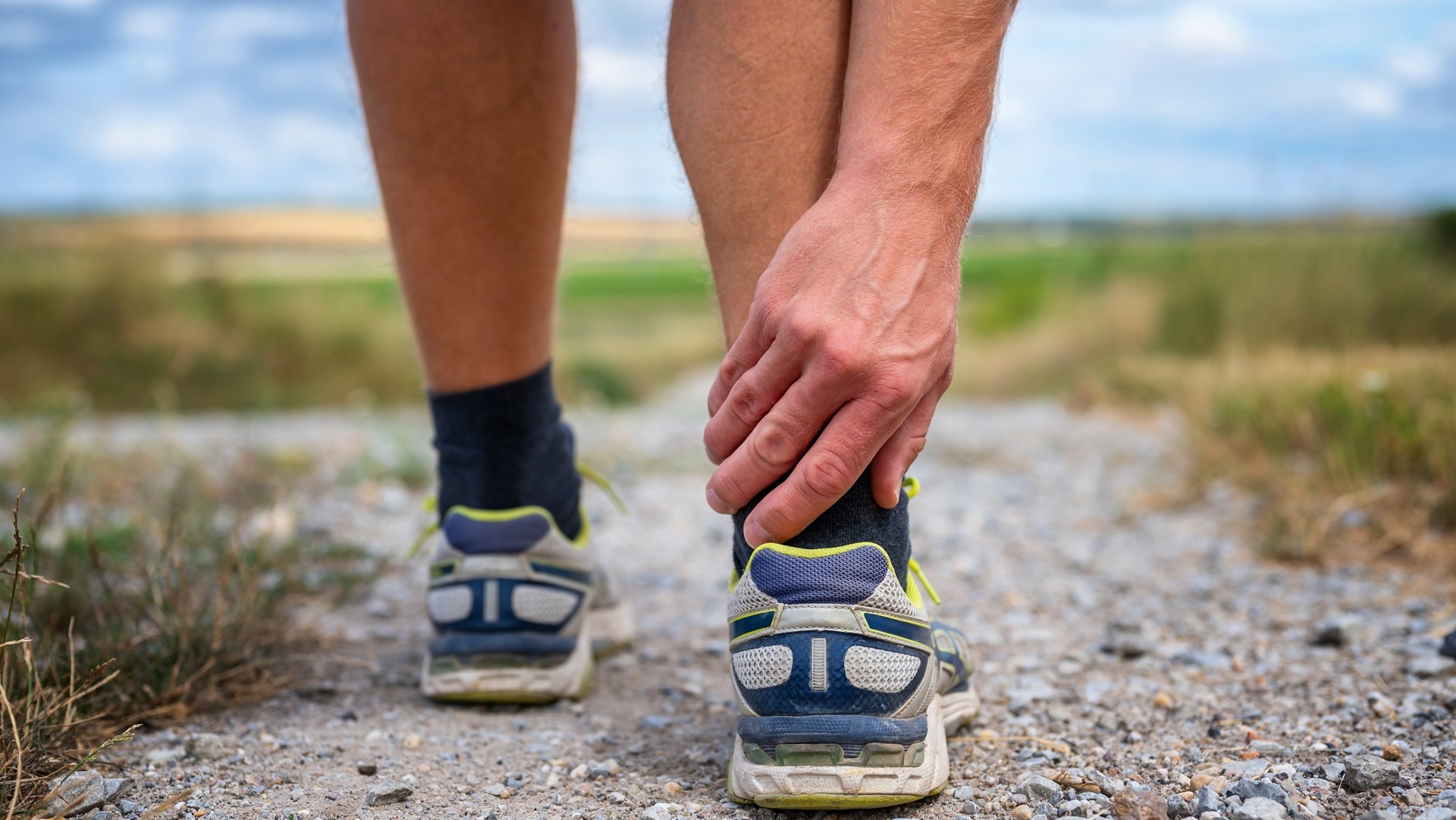
The Sports Podiatry Clinic Taylors Lakes manage a wide range of foot and ankle conditions. The following are some common injuries to the foot and ankle you can consult from our Sports Podiatrist in Taylors Lakes:
Heel Pain/Plantar Fasciitis
Achilles Tendonitis
Ankle Sprains
Medial Tibial Stress Syndrome/Shin Splints
Stress Fractures
1st MTPJ Pain/Pain of the Big Toe Joint
Forefoot Pain/Ball of the Foot Pain
Mortons Neuromas
Ganglions
Plantar Plate Tears
Bursitis
1. Heel Pain/Plantar Fasciitis
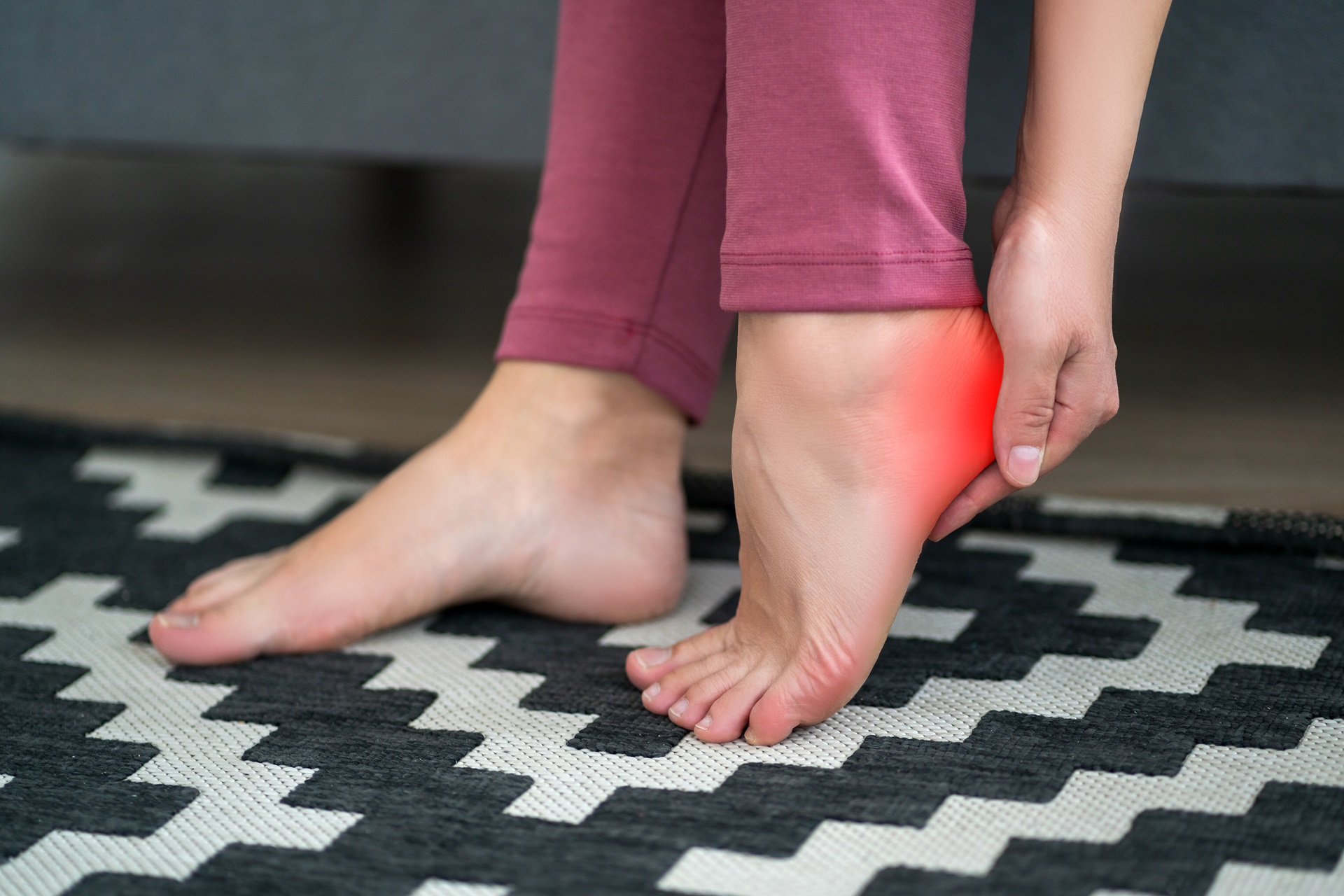
What is Plantar Fasciitis?
Plantar fasciitis is one of the most common causes of heel pain, affecting millions of people each year.
It involves inflammation of the plantar fascia, a thick band of tissue that runs across the bottom of your
foot and connects your heel bone to your toes. The plantar fascia supports the arch of the foot and
acts as a shock absorber, but repetitive stress and strain can lead to tiny tears in the fascia, resulting
in pain and inflammation.
Symptoms of Plantar Fasciitis
The primary symptom of plantar fasciitis is a sharp, stabbing pain in the bottom of the heel, usually
most intense with the first steps taken in the morning or after long periods of rest. The pain often
decreases as the foot warms up but may return after prolonged standing, walking, or after exercise.
Other symptoms may include tenderness when pressing on the bottom of the heel, stiffness, and
sometimes swelling. Over time, without proper treatment, the condition can worsen, causing chronic
heel pain and affecting mobility.
Causes of Plantar Fasciitis
Plantar fasciitis is typically caused by repetitive strain on the plantar fascia, leading to microtears in the tissue. Several factors can increase the risk of developing this condition, including:
- Overuse: High-impact activities like running, jumping, or walking on hard surfaces can strain
the plantar fascia. - Foot Mechanics: Flat feet, high arches, or abnormal walking patterns can cause uneven
distribution of weight and increased stress on the plantar fascia. - Improper Footwear: Shoes that lack proper arch support, cushioning, or have worn-out soles
can contribute to plantar fasciitis. - Obesity: Excess weight puts additional stress on the feet, especially the plantar fascia.
- Age: Plantar fasciitis is most common in people between the ages of 40 and 60.
- Occupational Factors: Jobs that require prolonged standing or walking on hard surfaces,
such as factory workers, teachers, and healthcare professionals, are at higher risk.
Management of Plantar Fasciitis
Effective management of plantar fasciitis involves a combination of treatments aimed at reducing pain, promoting healing, and preventing recurrence. Common management options include
- Rest and Activity Modification: Reduce activities that worsen pain and avoid long periods of standing or walking.
- Stretching Exercises: Stretch the plantar fascia, Achilles tendon, and calf muscles to improve flexibility.
- Ice Therapy: Apply ice for 15-20 minutes several times a day to reduce inflammation and
- Footwear: Wear supportive shoes with good arch support and cushioned A podiatrist can assess your foot type and gait to recommend the best footwear.
- Orthotics: Use custom orthotics or insoles to provide additional support and distribute pressure evenly across the foot.
- Shockwave Therapy: A non-invasive treatment that uses sound waves to promote healing and reduce pain. We offer shockwave therapy at our clinic for effective pain management.
- Physical Therapy: Strengthen lower leg muscles to improve stability and reduce
- And Many More!
Why See a Podiatrist for Plantar Fasciitis?
Seeing a podiatrist is essential for properly diagnosing and treating plantar fasciitis. Podiatrists specialise in foot and ankle conditions and can provide tailored treatment plans to address the specific cause of your heel pain. They can perform a thorough examination, use imaging studies like X-rays or ultrasound to rule out other conditions, and create custom orthotics to provide support. A podiatrist will also provide guidance on footwear, stretching exercises, and lifestyle modifications to prevent recurrence, ensuring you get back on your feet pain-free.
2. Achilles Tendonitis
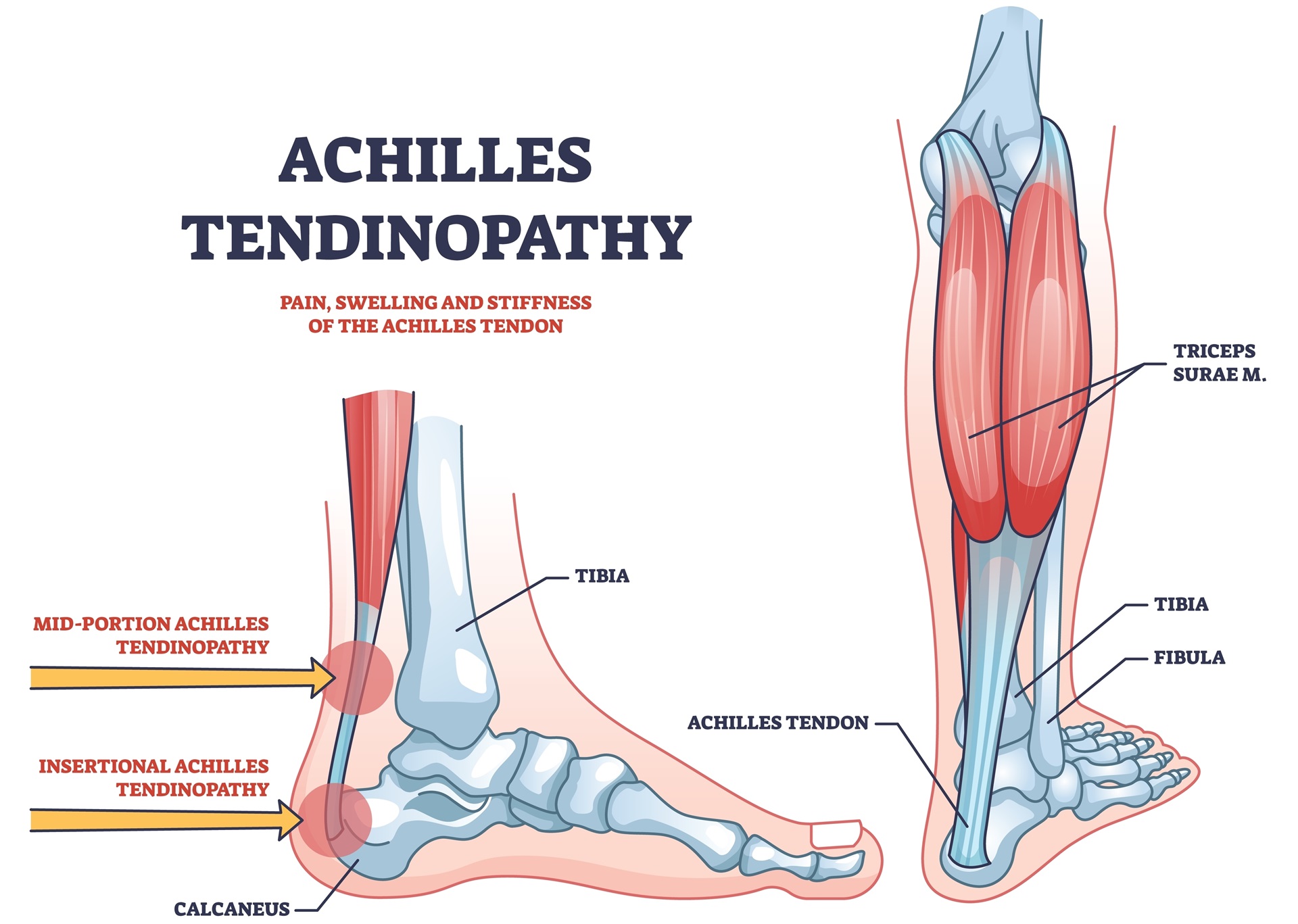
What is Achilles Tendonitis?
Achilles tendonitis is an overuse injury of the Achilles tendon, the band of tissue that connects the calf muscles to the heel bone. The Achilles tendon is the largest tendon in the body and plays a crucial role in walking, running, and jumping. When this tendon is subjected to repetitive stress or sudden increases in activity, it can become inflamed, leading to pain and swelling. Achilles tendonitis is common in athletes, particularly runners, but it can affect anyone, especially if they suddenly increase their activity level or wear improper footwear.
Symptoms of Achilles Tendonitis
Achilles tendonitis typically presents as pain and stiffness along the Achilles tendon, usually in the morning or after periods of rest. The pain may initially be mild and improve with activity, but it can worsen with prolonged exercise or intense physical activity. Other symptoms include
- Tenderness: The area around the tendon may be tender to touch, particularly 2-6 cm above the heel bone.
- Swelling: Swelling and thickening of the tendon may occur, especially in cases of chronic tendonitis.
- Limited Range of Motion: The ankle may feel stiff and less flexible, particularly when trying to flex the foot upward.
- Crepitus: A crackling or popping sensation may be felt when moving the ankle, indicating tendon inflammation.
Causes of Achilles Tendonitis
Achilles tendonitis often results from repetitive stress and strain on the tendon. Factors that can contribute to the development of Achilles tendonitis include
- Sudden Increase in Activity Level: A rapid increase in running distance, intensity, or frequency can overload the tendon.
- Improper Footwear: Shoes that lack proper arch support or cushioning, or those that are worn out, can place undue stress on the Achilles tendon.
- Foot Mechanics: Flat feet, high arches, or overpronation can cause the Achilles tendon to work harder, leading to inflammation.
- Tight Calf Muscles: Inflexible calf muscles can increase tension on the Achilles tendon, especially during physical activity.
- Age and Gender: Achilles tendonitis is more common in middle-aged men, but it can affect
- Sports Activities: Sports involving jumping, running, or sudden stops and starts, such as basketball, tennis, and soccer, can increase the risk of Achilles tendonitis.
Management of Achilles Tendonitis
Achilles tendonitis management focuses on relieving pain, reducing inflammation, and promoting healing. Treatment options include
- Rest and Activity Modification: Avoid activities that exacerbate the pain, such as running or jumping. Low-impact exercises like swimming or cycling can help maintain fitness without stressing the tendon.
- Ice Therapy: Applying ice packs to the affected area for 15-20 minutes several times a day can help reduce inflammation and pain.
- Stretching and Strengthening Exercises: Gentle stretches for the Achilles tendon and calf muscles can improve flexibility and reduce tension. Eccentric strengthening exercises are particularly beneficial in rehabilitation.
- Footwear and Orthotics: Wearing shoes with proper arch support and cushioned heels, or using custom orthotics, can reduce strain on the Achilles tendon.
- Shockwave Therapy: A non-invasive treatment that uses shock waves to promote healing and reduce pain. We offer shockwave therapy at our clinic for effective pain management.
- And Many More!
Why See a Podiatrist for Achilles Tendonitis?
Podiatrists are foot and ankle specialists who provide comprehensive care for Achilles tendonitis. They perform a thorough evaluation to determine the severity and underlying cause of the condition. A podiatrist can offer a range of treatments, from conservative options like custom orthotics and physical therapy to advanced interventions such as shockwave therapy or, in extreme cases, surgery. Additionally, a podiatrist can help develop a personalised rehabilitation program to strengthen the tendon, improve flexibility, and prevent future injuries, ensuring a safe and effective recovery.
3. Ankle Sprains

What is an Ankle Sprain?
An ankle sprain is a common injury that occurs when the ligaments that support the ankle stretch beyond their limits or tear. Ligaments are strong, fibrous tissues that connect bones to each other, providing stability to the joints. Ankle sprains are particularly common in sports and physical activities but can happen to anyone during everyday activities, such as walking on uneven surfaces or slipping. The severity of an ankle sprain can range from mild to severe, depending on the extent of the damage to the ligaments.
Symptoms of Ankle Sprains
The symptoms of an ankle sprain can vary based on the severity of the injury. Common symptoms include
- Pain: Sudden, sharp pain at the time of injury, especially when weight is placed on the affected foot.
- Swelling: Rapid swelling around the ankle joint, sometimes accompanied by bruising.
- Tenderness: The area around the injured ligaments may be sensitive to touch.
- Reduced Range of Motion: Difficulty moving the ankle or walking, with stiffness or instability.
- Bruising: Discoloration around the affected area may occur a few hours to days after the injury.
- Popping Sensation: A popping or snapping sound may be heard at the time of the injury, indicating possible ligament tearing.
Causes of Ankle Sprains
Ankle sprains are usually caused by twisting, turning, or rolling the ankle awkwardly, which can stretch or tear the ligaments that hold the ankle bones together. Common causes include
- Sports and Physical Activities: Sports that involve running, jumping, or quick changes of direction, such as basketball, soccer, and tennis, have a higher risk of ankle sprains.
- Walking or Running on Uneven Surfaces: Uneven ground or unstable surfaces can increase the risk of losing balance and spraining the ankle.
- Inappropriate Footwear: Wearing shoes that lack proper support, are too tight, or have high heels can increase the risk of an ankle sprain.
- Previous Ankle Injuries: A history of ankle sprains or weakness in the ankle joint can increase the likelihood of future sprains.
- Falls: Tripping, falling, or taking a misstep off a curb or stair can result in an awkward twist of the ankle, leading to a sprain.
Management of Ankle Sprains
The treatment and management of an ankle sprain depends on the severity of the injury, categorised as Grade 1 (mild), Grade 2 (moderate), or Grade 3 (severe). The primary goals are to reduce pain and swelling, restore normal range of motion, and prevent further injury. Common management options include
- I.C.E. Protocol: Rest, Ice, Compression, and Elevation are the first steps in managing an ankle sprain. Resting the ankle and avoiding weight-bearing activities prevent further damage. Applying ice packs reduces swelling and pain, while compression with an elastic bandage supports the injured area. Elevating the foot above heart level reduces swelling.
- Pain Relief Medications: Over-the-counter NSAIDs like ibuprofen or naproxen can help manage pain and inflammation.
- Immobilisation: In cases of moderate to severe sprains, immobilisation with a brace, splint, or boot may be necessary to protect the injured ligaments and allow for healing.
- Physical Therapy: A physical therapist or podiatrist can provide exercises to improve range of motion, strength, balance, and stability, reducing the risk of future sprains.
- Functional Rehabilitation: Gradual reintroduction of weight-bearing activities, followed by sport-specific exercises, helps restore full function and return to normal activities.
- Surgical Intervention: Surgery is rarely needed but may be considered for severe cases where there is a complete tear of the ligament or when conservative treatments fail.
Why See a Podiatrist for Ankle Sprains?
Seeing a podiatrist for an ankle sprain is crucial for proper diagnosis and management. A podiatrist can assess the severity of the sprain, rule out fractures or other injuries, and develop a customised treatment plan to promote healing. They can provide guidance on rehabilitation exercises, prescribe orthotics or ankle braces for support, and recommend preventive measures to avoid future sprains. Proper treatment from a podiatrist ensures a faster recovery and reduces the risk of chronic ankle instability, which can lead to recurrent sprains and long-term complications.
4. Medial Tibial Stress Syndrome/Shin Splints
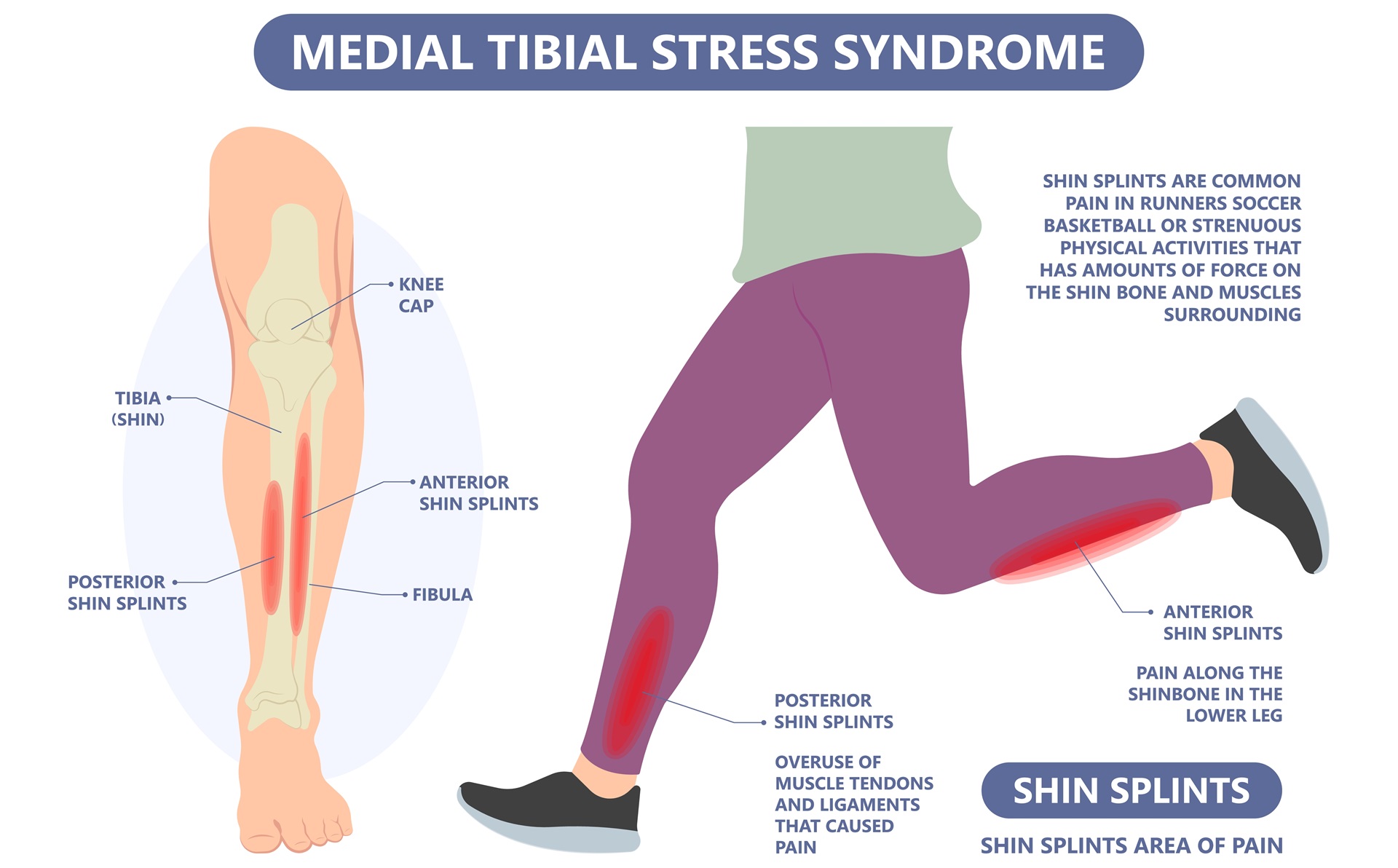
What is Medial Tibial Stress Syndrome (MTSS) or Shin Splints?
Medial tibial stress syndrome, commonly known as shin splints, refers to pain and inflammation along the inner edge of the shinbone (tibia). It is a common overuse injury that affects athletes, particularly runners, dancers, and military recruits. Shin splints occur when the muscles, tendons, and bone tissue around the tibia become inflamed, typically due to repetitive stress and strain. While shin splints are not a serious condition, they can be painful and, if left untreated, may progress to more severe injuries such as stress fractures.
Symptoms of Shin Splints
Shin splints are characterised by pain along the inner side of the shinbone, usually in the lower half. Symptoms can vary from mild discomfort to severe pain that limits activity. Common symptoms include
- Aching or Throbbing Pain: Pain that is often described as a dull ache or throbbing sensation along the inner shin.
- Tenderness and Swelling: The affected area may be tender to the touch, and swelling may occur in some cases.
- Pain During and After Exercise: Pain typically starts during physical activity and may worsen It is often most severe at the beginning of exercise, subsides during activity, and returns afterward.
- Worsening Pain with Continued Activity: As the condition progresses, pain may become more constant and occur even with minimal activity or at rest.
Causes of Shin Splints
Shin splints are primarily caused by repetitive stress and strain on the shinbone and the tissues attached to it. Contributing factors include
- Overuse and Overtraining: A sudden increase in training intensity, duration, or frequency can overload the muscles and bones of the lower leg.
- Improper Footwear: Wearing shoes that lack proper support or cushioning can increase the risk of shin splints.
- Flat Feet or High Arches: Abnormal foot mechanics, such as overpronation (flat feet) or supination (high arches), can increase stress on the lower leg.
- Running on Hard or Uneven Surfaces: Hard surfaces like concrete or uneven terrain can increase the impact on the shin, leading to shin splints.
- Lack of Flexibility or Muscle Imbalance: Tight calf muscles or weak stabilising muscles in the lower leg can contribute to the development of shin splints.
Management of Shin Splints
The treatment of shin splints focuses on relieving pain, reducing inflammation, and preventing recurrence. Common management strategies include
- Rest and Activity Modification: Resting the affected leg and avoiding high-impact activities that exacerbate the pain are crucial for recovery. Low-impact exercises like swimming or cycling can help maintain fitness without straining the shin.
- Ice Therapy: Applying ice packs to the affected area for 15-20 minutes several times a day can help reduce pain and inflammation.
- Supportive Footwear and Orthotics: Wearing proper shoes with good arch support and cushioning, or using custom orthotics, can help correct foot mechanics and reduce strain on the shin.
- Stretching and Strengthening Exercises: Stretching exercises for the calf muscles and Achilles tendon can improve flexibility, while strengthening exercises for the lower leg muscles can improve stability and reduce the risk of recurrence.
- AND Many More!
Why See a Podiatrist for Shin Splints?
A podiatrist plays a vital role in diagnosing and treating shin splints. They can assess foot biomechanics, identify contributing factors, and develop a personalised treatment plan to address the root cause of the condition. A podiatrist can recommend appropriate footwear, provide custom orthotics to correct alignment issues, and guide rehabilitation exercises. By addressing the underlying causes and providing expert care, a podiatrist can help prevent recurrence and ensure a safe return to physical activity.
5. Stress Fractures
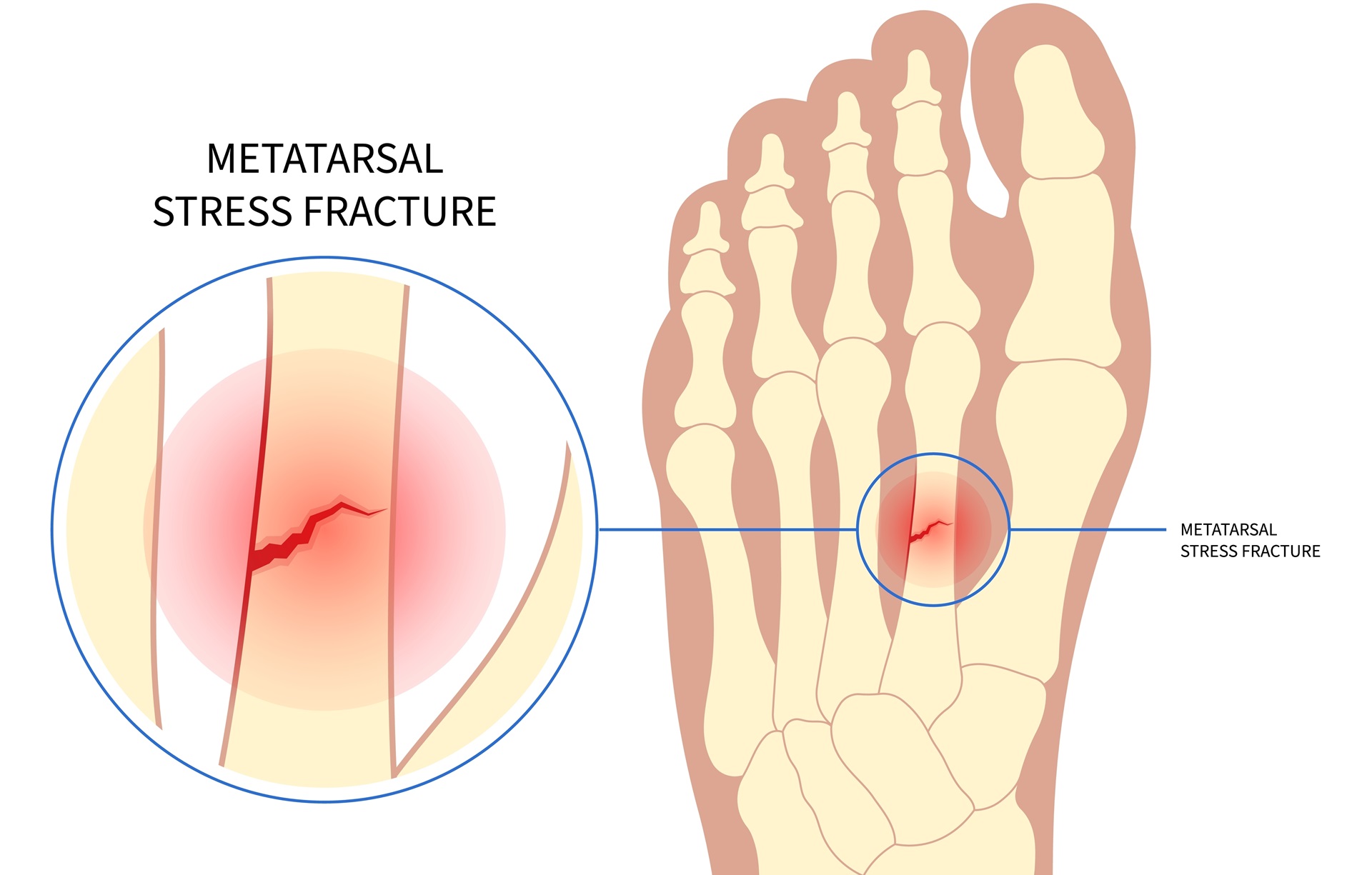
What is a Stress Fracture?
A stress fracture is a small crack or severe bruising within a bone, often caused by repetitive force or overuse. Unlike acute fractures that result from a single traumatic event, stress fractures develop gradually over time due to repeated stress on a bone. They are most common in the weight-bearing bones of the lower leg and foot, such as the metatarsals, tibia, and navicular bones. Stress fractures are particularly common among athletes, especially runners and dancers, but can affect anyone who engages in repetitive, high-impact activities.
Symptoms of a Stress Fracture
Stress fractures typically present with localised pain that develops gradually and worsens with activity. Symptoms can include
- Localised Pain: A sharp or aching pain at a specific point on the bone, often described as "pinpoint" pain, which intensifies with weight-bearing activities
- Swelling and Tenderness: Mild to moderate swelling may occur around the site of the fracture, along with tenderness when pressing on the affected area.
- Pain that Improves with Rest: The pain generally subsides with rest and returns when resuming activity.
- Visible Bruising or Redness: In some cases, bruising or redness may appear over the site of the stress fracture.
- Worsening Pain Over Time: Without appropriate management, the pain may become more severe and persist even at rest or with minimal activity.
Why Do Stress Fractures Occur?
Stress fractures occur when repetitive forces exerted on a bone exceed its ability to repair itself. Factors that contribute to the development of stress fractures include
- Overuse and Repetitive Activities: Activities that involve repetitive impact on bones, such as running, jumping, or dancing, can overload the bone The constant strain prevents the bone from healing naturally.
- Sudden Increase in Physical Activity: A rapid escalation in the intensity, duration, or frequency of exercise, such as when a runner increases mileage too quickly, can lead to stress fractures.
- Improper Footwear: Wearing shoes that lack adequate support, cushioning, or proper fit can increase stress on certain bones, particularly in the feet.
- Bone Density Issues: Conditions such as osteoporosis, low bone mineral density, or nutritional deficiencies (like insufficient calcium or vitamin D) can weaken bones, making them more susceptible to fractures.
- Foot Biomechanics: Abnormal foot mechanics, such as high arches or flat feet, can alter the distribution of forces during movement, increasing the risk of stress fractures.
- Gender and Hormonal Factors: Women, especially those with irregular menstrual cycles or conditions like the female athlete triad (disordered eating, amenorrhea, and osteoporosis), are at higher risk due to potential hormonal imbalances affecting bone density.
Common Management Options for Stress Fractures
The primary goal in managing a stress fracture is to allow the bone to heal while minimising pain and preventing further damage. Management strategies include
- Rest and Activity Modification: Ceasing the activity that caused the fracture is essential for recovery. Non-weight-bearing activities, such as swimming or cycling, can help maintain fitness levels without putting stress on the fracture.
- Protective Footwear or Braces: Wearing supportive footwear, such as stiff-soled shoes or orthopaedic walking boots, can reduce stress on the affected bone and provide stability. In severe cases, crutches may be necessary to completely offload the weight from the bone.
- Gradual Return to Activity: Once the bone has sufficiently healed, a gradual return to physical activity is This involves slowly increasing the intensity and duration of exercise while monitoring for any signs of pain.
- Physical Therapy: A Podiatrist or physical therapist can provide exercises to strengthen the muscles around the injured area, improve flexibility, and enhance overall body mechanics to prevent future fractures.
- Orthotic Devices: Custom orthotic devices may be prescribed to correct abnormal foot mechanics and provide better shock absorption during activities.
Why See a Podiatrist for Stress Fractures?
Seeing a podiatrist is essential for accurately diagnosing and managing stress fractures. Podiatrists have specialised knowledge in foot and lower limb biomechanics and can perform thorough evaluations to identify risk factors that may have contributed to the injury. They can utilise imaging techniques like X-rays or MRI to confirm a stress fracture diagnosis and determine its severity. A podiatrist can develop a tailored treatment plan that includes proper footwear recommendations, orthotic devices, rehabilitation exercises, and a safe return-to-activity strategy. Early intervention and expert guidance from a podiatrist can prevent the stress fracture from progressing to a complete fracture and reduce the risk of recurrence.
6. 1st MTPJ Pain/Pain of the Big Toe Joint
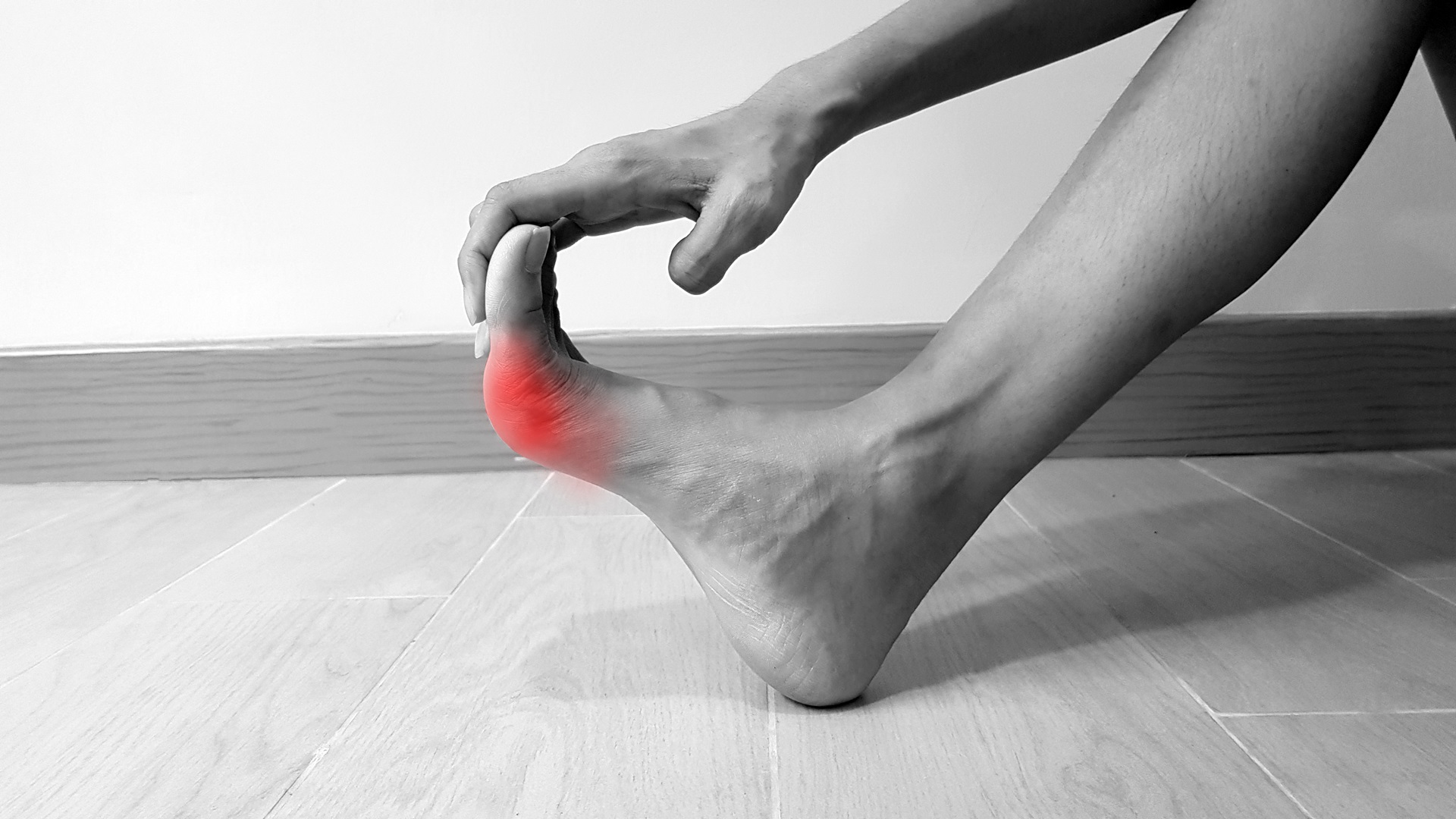
What is 1st MTPJ Pain?
The 1st Metatarsophalangeal Joint (MTPJ) refers to the joint at the base of the big toe, where the first metatarsal bone meets the proximal phalanx of the big toe. Pain in this joint, commonly referred to as 1st MTPJ pain, can result from various conditions, such as hallux limitus, hallux rigidus, gout, arthritis, or bunions. This joint is crucial for normal walking mechanics, as it plays a significant role in the push-off phase of gait. Pain or dysfunction in the 1st MTPJ can significantly impact mobility and quality of life.
Symptoms of 1st MTPJ Pain
Symptoms of 1st MTPJ pain can vary depending on the underlying cause. Common symptoms include
- Pain and Tenderness: Pain, which can be sharp or aching, is often felt on the top or side of the joint, particularly during walking or weight-bearing activities.
- Swelling and Redness: The joint may appear swollen and red, particularly in inflammatory conditions like gout or arthritis.
- Stiffness and Limited Motion: Reduced range of motion in the big toe joint, especially difficulty bending the toe upward (dorsiflexion), is common in conditions like hallux limitus or hallux rigidus.
- Bony Prominence: A visible bump or bony growth (osteophytes) may form on the top of the joint, particularly in cases of osteoarthritis or bunions.
- Difficulty Wearing Shoes: Pain and swelling can make wearing certain types of shoes, especially tight or narrow-toed shoes, uncomfortable or painful.
Why Does 1st MTPJ Pain Occur?
There are several conditions and factors that can lead to pain in the 1st MTPJ, including:
- Hallux Limitus/Rigidus: A degenerative joint disorder characterised by limited range of motion in the big toe joint, often progressing to hallux rigidus, where the joint becomes completely stiff.
- Bunions (Hallux Valgus): A bunion is a deformity where the big toe deviates laterally, causing the 1st MTPJ to protrude This misalignment can lead to pain, swelling, and reduced function.
- Gout: A type of inflammatory arthritis caused by the buildup of uric acid crystals in the joint, leading to sudden, severe pain, redness, and swelling in the big toe.
- Osteoarthritis: Wear and tear of the joint cartilage can lead to pain, stiffness, and the formation of bony growths in the 1st MTPJ.
- Trauma or Injury: Injuries, such as stubbing the toe or repetitive stress from sports, can cause pain and inflammation in the joint.
Common Management Options for 1st MTPJ Pain
Effective management of 1st MTPJ pain depends on identifying the underlying cause and addressing the contributing factors. Common treatment options include
- Footwear Modification: Wearing shoes with a wide toe box, stiff soles, or rocker-bottom soles can reduce pressure on the big toe joint and improve comfort.
- Orthotics and Padding: Custom orthotics can provide support, reduce stress on the joint, and help correct foot alignment issues. Gel pads or cushions can alleviate pressure on
- Medications: Nonsteroidal anti-inflammatory drugs (NSAIDs) can help reduce pain and inflammation. In cases of gout, specific medications to lower uric acid levels may be
- Physical Therapy: Targeted exercises to improve joint mobility, strengthen surrounding muscles, and maintain flexibility can help alleviate pain and prevent stiffness.
- Corticosteroid Injections: In cases of severe pain and inflammation, corticosteroid injections may provide temporary relief.
- Surgical Intervention: Surgery may be considered for advanced cases, such as bunionectomy for bunions or cheilectomy for hallux rigidus, to remove bony growths or realign the joint.
Why See a Podiatrist for 1st MTPJ Pain?
Consulting a podiatrist is essential for accurately diagnosing the cause of 1st MTPJ pain and developing an effective treatment plan. Podiatrists can perform a thorough clinical evaluation, use imaging techniques, and consider the patient's overall biomechanics to determine the best course of action. They can provide expert advice on appropriate footwear, prescribe custom orthotics, offer conservative management options, and perform surgical interventions if necessary. Early diagnosis and treatment by a podiatrist can prevent the condition from worsening and help maintain mobility and quality of life.
7. Forefoot Pain/Ball of the Foot Pain
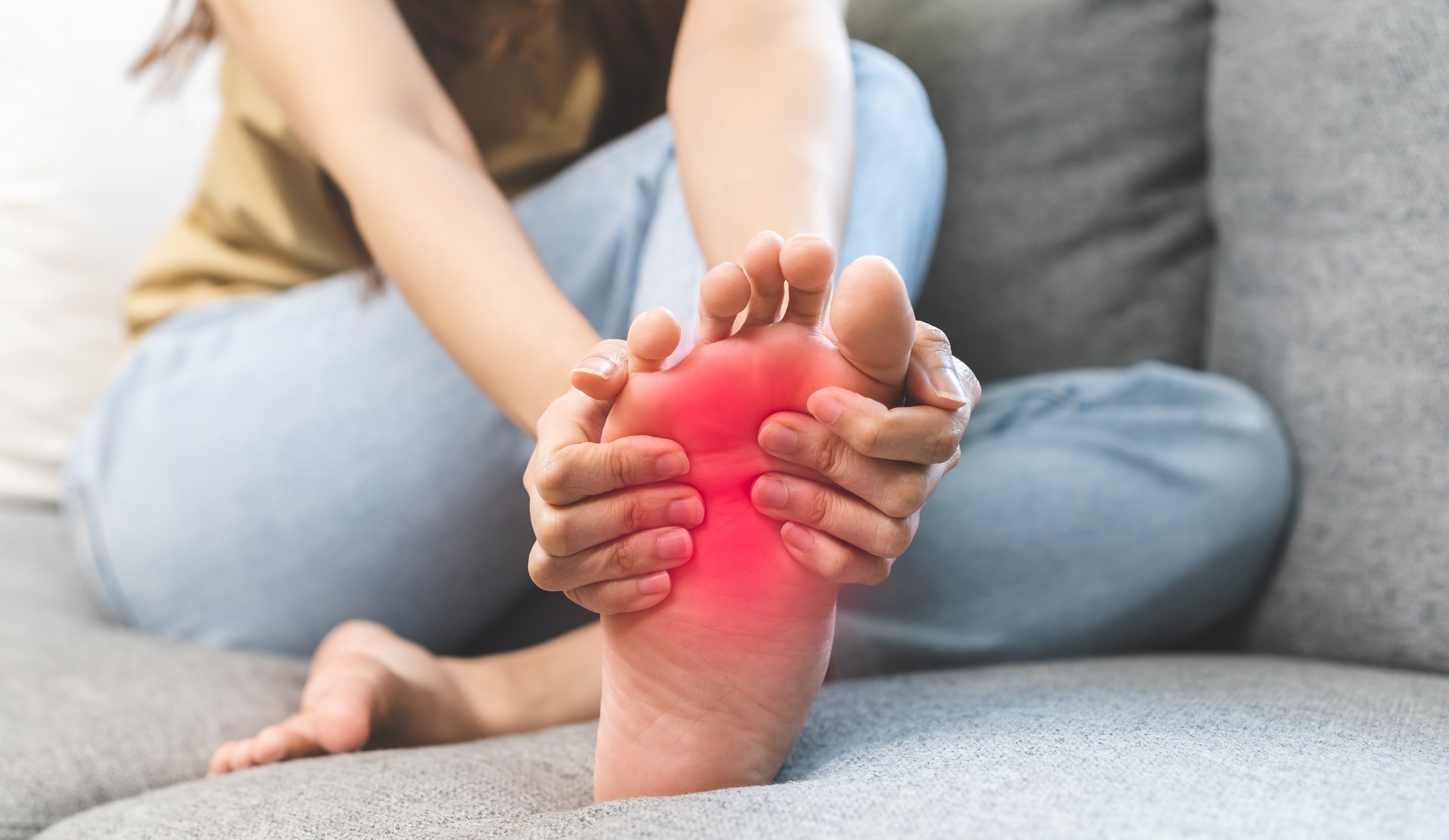
What is Forefoot Pain?
Forefoot pain, often referred to as "ball of the foot pain," encompasses a range of conditions that cause discomfort in the front part of the foot, typically under the metatarsal heads. This area absorbs a significant amount of pressure during walking, running, and other weight-bearing activities. Common conditions associated with forefoot pain include metatarsalgia, Morton’s neuroma, capsulitis, and sesamoiditis. These conditions can significantly affect daily activities, especially when left untreated.
Symptoms of Forefoot Pain
Symptoms of forefoot pain can vary depending on the underlying cause but commonly include
- Sharp, Aching, or Burning Pain: Pain is typically felt in the ball of the foot, just behind the toes. It may worsen during activities like walking, running, or standing.
- Numbness or Tingling: This can occur in the toes or the ball of the foot, especially if a nerve is compressed.
- Swelling and Inflammation: Swelling may occur on the bottom of the foot near the toes.
- Feeling of a Pebble in the Shoe: Some patients describe a sensation as if they are stepping on a small stone or having something bunched up in their shoe.
Why Does Forefoot Pain Occur?
Forefoot pain can be caused by various factors, including:
- Overuse and High-Impact Activities: High-impact sports or activities that involve running, jumping, or frequent changes in direction can lead to repetitive stress on the forefoot.
- Improper Footwear: Shoes that are too tight, narrow, or lack proper arch support can place excessive pressure on the metatarsals.
- Foot Structure and Biomechanics: High arches, flat feet, or misalignment of the toes can alter the pressure distribution on the forefoot, increasing the risk of pain.
- Age and Weight: As people age, the fat pads on the soles of the feet thin out, offering less cushioning. Excessive body weight can also put additional strain on the forefoot.
- Underlying Conditions: Conditions like arthritis, diabetes, and nerve-related issues can contribute to forefoot pain.
Common Management Options for Forefoot Pain
Management of forefoot pain focuses on relieving pressure, reducing inflammation, and addressing any underlying biomechanical issues:
- Rest and Activity Modification: Limiting activities that exacerbate pain, such as running or jumping, is crucial. Non-impact exercises like swimming or cycling can be alternatives.
- Proper Footwear: Shoes with a wide toe box, good arch support, and shock-absorbing soles can help reduce pressure on the forefoot.
- Orthotic Devices: Custom orthotics or metatarsal pads can redistribute pressure away from the painful areas and provide cushioning.
- Physical Therapy: Exercises to strengthen the muscles of the foot and improve flexibility can help alleviate pain and prevent future issues.
- Medications: NSAIDs (Nonsteroidal anti-inflammatory drugs) can help manage pain and
- Corticosteroid Injections: In cases of severe pain, corticosteroid injections may provide
- Surgical Intervention: If conservative treatments fail, surgery may be considered to address structural abnormalities or remove a neuroma.
Why See a Podiatrist for Forefoot Pain?
Seeing a podiatrist is important for accurately diagnosing the specific cause of forefoot pain and determining the most appropriate treatment plan. Podiatrists are trained to assess foot mechanics and identify issues that contribute to pain. They can provide customised orthotics, advice on proper footwear, and recommend exercises or other interventions to relieve pain. In cases requiring surgery, a podiatrist can perform procedures to correct deformities or remove problematic growths.
8. Morton’s Neuromas
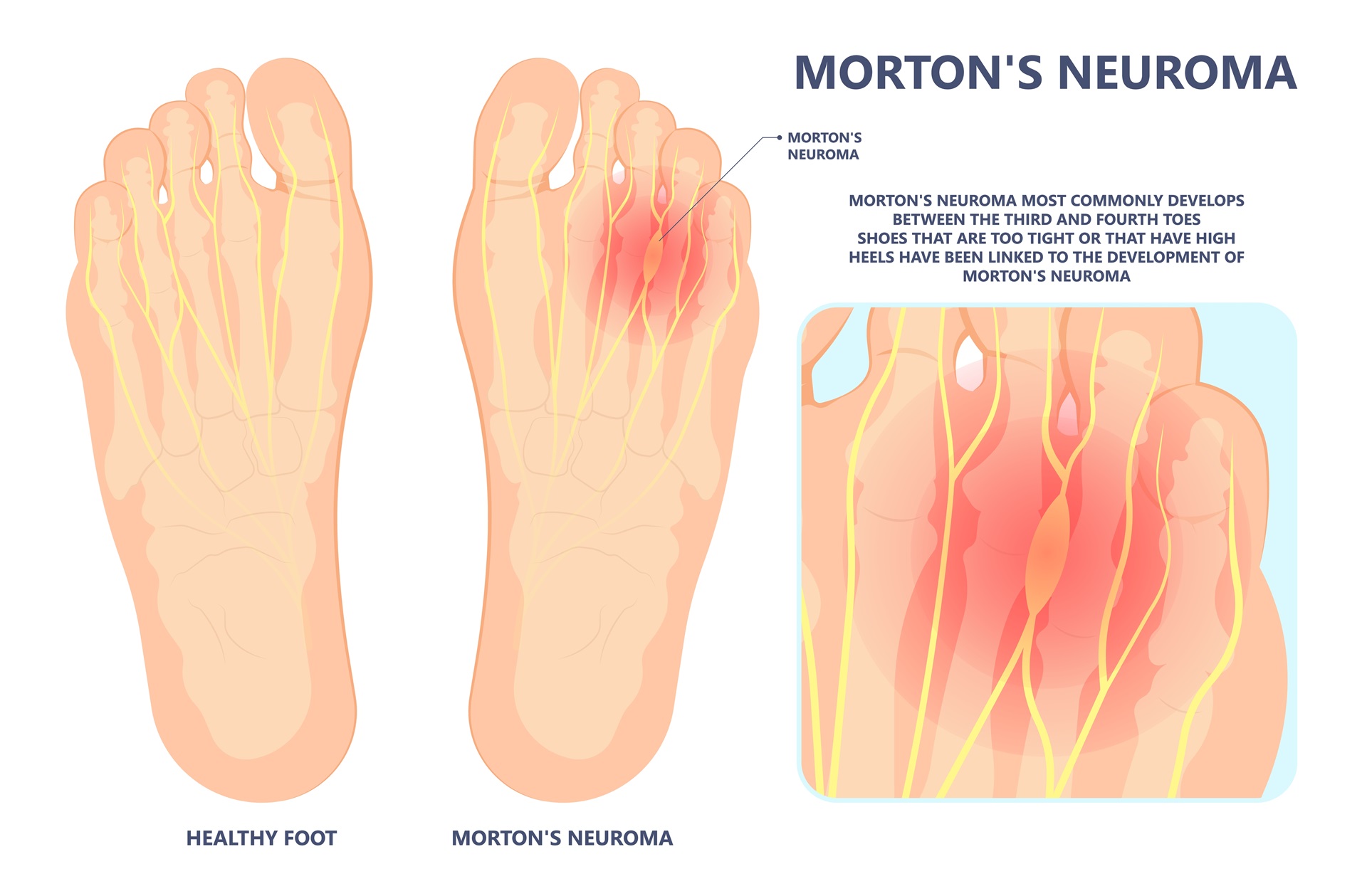
What is Morton’s Neuroma?
Morton’s neuroma is a painful condition that affects the ball of the foot, most commonly between the third and fourth toes. It involves the thickening of the tissue around one of the nerves leading to the toes, resulting in nerve irritation and compression. Morton’s neuroma is often associated with high-heeled shoes or activities that place excessive pressure on the forefoot.
Symptoms of Morton’s Neuroma
Common symptoms associated with Morton’s neuroma include
- Sharp or Burning Pain: This pain is typically felt in the ball of the foot and may radiate into the toes.
- Numbness or Tingling: Numbness, tingling, or a "pins and needles" sensation can occur in the toes.
- Feeling of a Lump: Some individuals report a sensation as if they have a lump or pebble under the ball of their foot.
- Pain that Worsens with Activity: Walking, running, or wearing tight shoes can exacerbate the pain.
Why Does Morton’s Neuroma Occur?
The development of Morton’s neuroma is often linked to factors that increase pressure on the forefoot and irritate the nerve:
- Footwear Choices: Wearing tight, narrow shoes or high heels that compress the toes can aggravate the nerves.
- High-Impact Activities: Activities such as running or jumping can cause repetitive trauma to the nerves in the foot.
- Foot Deformities: Conditions like bunions, hammertoes, or high arches can increase the risk of developing Morton’s neuroma by altering pressure distribution.
- Biomechanical Issues: Abnormal gait or improper foot mechanics can contribute to nerve
Common Management Options for Morton’s Neuroma
The primary aim in managing Morton’s neuroma is to reduce pressure on the nerve and alleviate pain:
- Footwear Modification: Switching to shoes with a wide toe box, low heels, and adequate arch support can help relieve pressure on the affected area.
- Orthotics and Padding: Custom orthotics or metatarsal pads can help offload pressure from the nerve and provide support.
- Activity Modification: Reducing high-impact activities that exacerbate symptoms can aid in
- Physical Therapy: Stretching and strengthening exercises can help improve foot mechanics and reduce nerve irritation.
- Medications and Injections: NSAIDs can help manage pain, while corticosteroid injections may provide temporary relief by reducing inflammation.
- Surgical Intervention: In severe cases, surgical removal of the affected nerve may be
Why See a Podiatrist for Morton’s Neuroma?
A podiatrist can provide an accurate diagnosis of Morton’s neuroma through a comprehensive assessment and imaging if needed. They can recommend appropriate footwear, prescribe custom orthotics, and provide physical therapy exercises to alleviate symptoms. In cases where conservative treatments are ineffective, a podiatrist can perform surgical procedures to remove the neuroma or relieve pressure on the affected nerve.
9. Ganglions

What is a Ganglion?
A ganglion cyst is a non-cancerous lump that typically develops along the tendons or joints of the wrists or feet. In podiatry, ganglions often appear on the top of the foot or around the ankle. These fluid-filled cysts are generally harmless but can cause discomfort or pain if they press on a nerve or interfere with joint movement.
Symptoms of Ganglions
Ganglions may present with various symptoms depending on their size and location:
- Visible Lump: The most common sign of a ganglion is a visible, soft, and round lump on the foot or ankle.
- Pain and Discomfort: The cyst may cause pain, especially when it compresses nearby nerves or when the foot is in use.
- Decreased Range of Motion: Larger ganglions may restrict joint movement.
- Fluctuating Size: The size of a ganglion cyst can change over time, becoming larger or
Why Do Ganglions Occur?
The exact cause of ganglion cysts is not well understood, but several factors may contribute to their development:
- Repetitive Stress or Trauma: Repetitive movements or injuries to the foot can lead to the formation of ganglions.
- Joint or Tendon Irritation: Chronic irritation of the tendons or joints may increase the risk of cyst formation.
- Underlying Joint Conditions: Conditions like osteoarthritis may be associated with the development of ganglions.
Common Management Options for Ganglions
Management of ganglions depends on their size, location, and the level of discomfort they cause:
- Observation: Small, asymptomatic ganglions may not require treatment and can be monitored for changes.
- Footwear Modification: Wearing comfortable shoes that do not press on the cyst can help alleviate pain.
- Aspiration: Aspiration involves draining the fluid from the cyst with a needle, often combined with a corticosteroid injection to reduce inflammation.
- Surgery: If conservative measures fail or the ganglion recurs, surgical removal may be
Why See a Podiatrist for Ganglions?
A podiatrist can provide a definitive diagnosis of a ganglion through physical examination and imaging. They can offer appropriate treatment options, such as aspiration or surgical removal, if needed. Seeing a podiatrist ensures that any underlying causes are addressed, and the risk of recurrence is minimised.
10. Plantar Plate Tears
What is a Plantar Plate Tear?
The plantar plate is a thick ligament-like structure that supports the toes and maintains the integrity of the metatarsophalangeal joints (MTPJs). A tear in the plantar plate, typically occurring at the second MTPJ, can lead to pain, instability, and deformities like hammertoes or crossover toes.
Symptoms of Plantar Plate Tears
Common symptoms of a plantar plate tear include
- Pain in the Ball of the Foot: Pain is usually felt under the affected toe and may increase with
- Swelling and Bruising: Swelling and bruising may occur around the MTPJ.
- Toe Deformity: The affected toe may appear lifted or deviated, and in some cases, it may overlap with adjacent toes.
- Instability: There may be a feeling of instability or weakness in the toe, especially when walking or standing.
Why Do Plantar Plate Tears Occur?
Several factors can contribute to the development of a plantar plate tear:
- Excessive Toe Dorsiflexion: Activities that involve repeated toe dorsiflexion, such as dancing or running, can stress the plantar plate.
- Foot Structure and Biomechanics: Flat feet, high arches, or long second toes can increase the risk of plantar plate tears.
- Aging and Degeneration: The plantar plate may weaken and degenerate with age, increasing the likelihood of tears.
- Trauma or Injury: Direct trauma or hyperextension injuries can cause an acute
Common Management Options for Plantar Plate Tears
Treatment focuses on reducing pain, stabilising the toe, and preventing further damage:
- Rest and Activity Modification: Limiting activities that exacerbate pain and avoiding high-impact sports can help the plantar plate heal.
- Footwear and Orthotics: Supportive footwear and custom orthotics can help offload pressure from the affected area and provide stability.
- Taping and Splinting: Taping or splinting the affected toe can help maintain alignment and prevent further damage.
- Physical Therapy: Strengthening exercises for the intrinsic foot muscles can improve stability and support the plantar plate.
- Anti-inflammatory Medications: NSAIDs can help manage pain and inflammation.
- Surgical Repair: In cases of severe tears or when conservative measures fail, surgical repair may be required to restore the integrity of the plantar plate.
Why See a Podiatrist for Plantar Plate Tears?
A podiatrist is skilled in diagnosing plantar plate tears through physical examination and imaging. They can provide tailored treatment plans, including orthotics, taping, and surgical options if necessary, to ensure optimal recovery and prevent recurrence.
11. Bursitis
